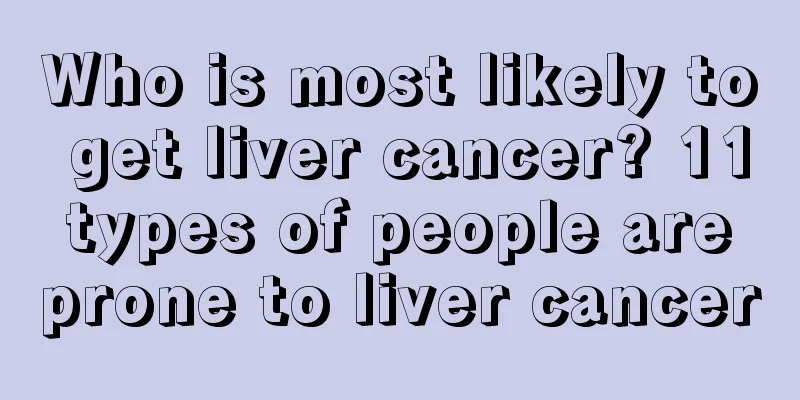Who is most likely to get liver cancer? 11 types of people are prone to liver cancer

|
my country is a country with a high incidence of liver diseases, and liver diseases often lead to liver cancer. Liver cancer is highly malignant and progresses very quickly. Usually, there is no discomfort in the early stage, and once symptoms appear, it is often in the middle or late stage. Therefore, the treatment is difficult and the efficacy is poor. Generally, the survival time after onset is only 6 months, and it is called the "king of cancer." 11 types of people are prone to liver cancer 1. People with a family history of liver cancer On the one hand, many inherited diseases that damage the liver, such as pigmentation disease and glycogen storage disease, will develop into cirrhosis, and the incidence of liver cancer is also very high; on the other hand, it is believed that the familial clustering of liver cancer is mainly caused by the clustering of hepatitis B virus. There is currently no evidence that liver cancer can be inherited. 2. Patients with post-hepatitis cirrhosis More than 50% of patients with cirrhosis develop cancer, and most of them have recurrent symptoms, poor liver function improvement, and frequent complications such as ascites. 3. People living in areas with a high incidence of liver cancer The high incidence areas of liver cancer in China are mainly in the southeastern coastal areas, such as Fusui and Longan in Guangxi, Xiamen and Tongan in Fujian, Qidong and Haimen in Jiangsu, Chongming and Nanhui in Shanghai, etc. In these areas, at least 30 people die of liver cancer per 100,000 people. In addition, the incidence of liver cancer is higher in coastal areas than in inland areas, and higher in southeastern and northeastern regions than in southwest and northwest regions. 4. Chronic alcoholics Long-term alcohol abuse can significantly damage liver cells and lead to malnutrition, making the liver prone to cirrhosis, which can develop into liver cancer. Of course, in addition to the above dietary factors, hepatitis B, parasitic diseases in the liver (such as Clonorchis sinensis), and genetic susceptibility are also closely related to the occurrence of liver cancer. It should be pointed out here that when the above two factors come into play, liver cancer is more likely to occur, such as hepatitis B and aflatoxin exposure, which will cause the disease faster. Alcohol poisoning can also cause alcoholic fatty liver, alcoholic hepatitis, and alcoholic cirrhosis. In alcoholic hepatitis or cirrhosis, the number of Kupffer cells decreases, which can increase the occurrence of liver cell cancer. 5. People living in difficult conditions The occurrence of liver cancer has an occupational characteristic, and farmers have the highest incidence and mortality rates. Some people say that in China, liver cancer and stomach cancer are diseases caused by poverty, and people with poor economic conditions are more likely to suffer from "liver cancer", which makes sense. 6. Gene mutation Mutagens and viruses in the environment stimulate the activation of liver cell division response pathways, causing point mutations and gene translocations in cells, which are possible factors that accelerate the proliferation of cancer cells. 7. People who drink unhealthy water Water is an important substance for maintaining the normal survival of human organisms. Water itself certainly does not cause tumors, but epidemiological surveys have shown that the degree of drinking water pollution is positively correlated with the incidence of liver cancer. This undoubtedly indicates that there are carcinogens in the water source, and it may be the combined effect of multiple carcinogens, such as humic acid, blue-green algae toxins, etc. 8. People who eat food contaminated by Aspergillus flavus More than 30 years ago, a farm in the UK fed turkeys with peanut cake that was moldy due to Aspergillus flavus, which caused the death of 100,000 chicks. Epidemiological studies have shown that the geographical distribution of liver cancer in my country is basically consistent with the distribution of aflatoxin contamination. In areas where grain, oil and food are seriously contaminated by aflatoxin B1, the incidence and mortality of liver cancer are also high. Aflatoxin is a carcinogen that grows and reproduces in hot and humid environments. If humans eat moldy grains for a long time in the summer, they will be infected with aflatoxin and liver cancer will occur. 9. People who take in too much nitrosamine compounds Dimethylnitrosamine has been isolated from the food of residents in South Africa, a high-risk area for liver cancer. This type of compound can also cause other tumors such as esophageal cancer. Therefore, nitrosamine compounds are also classified as one of the causes of liver cancer. 10. People who take in too little trace elements Current research on the relationship between trace elements and liver cancer has found that the mortality rate from liver cancer is negatively correlated with the selenium content in the environment and with the blood selenium level of residents. Animal experiments have shown that selenium can block aflatoxin-induced liver cancer in rats and ducks. 11. People who are affected by complex factors Overnutrition (macronutrients) or nutritional deficiency (such as vitamin A, B1 deficiency), hemochromatosis, parasitic infection and heredity are also risk factors for liver cancer. People at high risk of liver cancer need regular lifelong checkups Although liver cancer ranks second to lung cancer in terms of morbidity and mortality, it is difficult to detect and diagnose because of its mild early symptoms. It always breaks out in the final stage, so it is not unreasonable to call it "the cancer among cancers". The best treatment stage for liver cancer is in the early stage of the tumor, when the tumor has not yet expanded and metastasized. The best way is to kill it with surgery. Early detection and early treatment are the advice of every doctor. It is also an aspect that every patient, including healthy people, should be vigilant and pay attention to. Every disease has its own high-risk group, and liver cancer is no exception. The high-risk group for liver cancer is the group with the highest possibility of developing liver cancer. Among this group, the first people who can be thought of are those who have a history of liver cancer. They have had liver cancer before, so the possibility of tumor recurrence and recurrence is much higher than that of the healthy group. In addition, long-term carriers of hepatitis B virus should also be included in the scope of high-risk groups for liver cancer, because hepatitis B virus is a common cause of liver cancer. Middle-aged people over 40 years old, if they suffer from hepatitis or cirrhosis, are also one of the high-risk groups for liver cancer. If you carry the hepatitis B virus for a long time and drink a lot of alcohol for a long time, the chance of developing liver cancer with cirrhosis is higher. For high-risk groups, they should be more alert to subtle changes in their bodies. If you are at high risk of liver cancer, you should do early detection and early treatment to prevent it. There is no way out. The only way is to have regular liver examinations. Ordinary people have physical examinations once a year, while people at high risk of liver cancer have physical examinations every three months, and once they are determined to be at high risk of liver cancer, such examinations must be continued for life. On the surface, it may seem troublesome that such a high frequency of examinations must be continued for a lifetime, but in fact, it is not troublesome. This examination is actually just a B-ultrasound and a blood draw. The B-ultrasound is to understand whether there are abnormal nodules or masses in the liver, and the blood draw is to understand liver function, alpha-fetoprotein and hepatitis B virus DNA. Most people are worried about the cost of doing a liver examination every three months. "The annual physical examination method for people at high risk of liver cancer is different from that of normal people. The cost of a three-month examination is definitely higher than that of a normal person, but the cost of these four examinations is actually not that expensive. It's only about 800 yuan a year." Such regular examinations are very important for people at high risk of liver cancer. They can definitely prevent cancer before it happens and help with early detection and treatment. |
<<: Is lung cancer hereditary? Lung cancer patients can take these to relieve pain
>>: Does liver cancer run in families? These six types of people are prone to liver cancer
Recommend
What is the definition of fibroid
Fibroid is a common and frequent disease in moder...
What is the process of the gestational sac becoming the placenta?
When pregnant women reach the middle and late sta...
How much does immunotherapy for lung cancer cost per year?
There is also an immunotherapy for lung cancer no...
How to treat interstitial colon?
The symptoms of interpositioned colon are severe ...
What causes primary liver cancer? The three most common causes of primary liver cancer
There are many common causes of primary liver can...
What to do if you vomit blood after drinking too much
For those friends who vomit blood after drinking ...
The effects of raw and cooked radish
The effects of raw radish and cooked radish are t...
Eat a full meal in the morning or eat well in the morning
As the saying goes, eat full in the morning, eat ...
What medicine can cure a cold caused by internal heat quickly?
Many people usually have symptoms of getting angr...
What are the harms of facial paralysis to the body
Facial paralysis is a curable disease with many c...
Can a razor shave underarm hair?
Can a razor be used to shave underarm hair? Many ...
Chinese medicine secret recipe for treating bladder cancer
Bladder cancer can be divided into many categorie...
What are the causes of gastric cancer
With the development of society, the pace of life...
What to do if you get scalded by cooking oil
If you are not careful when cooking, it is easy t...
What foods can prevent liver cancer
Preventing liver cancer is something everyone sho...









